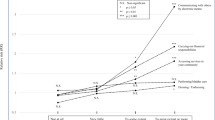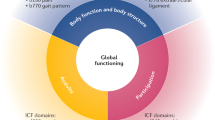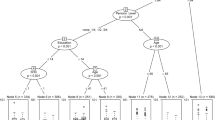Abstract
Symptoms and functional limitations are commonly reported primary outcome measures in ankylosing spondylitis (AS); however, participation has not been widely evaluated, as reflected by the scarcity of literature on the subject. People with AS suggest that participation in social roles (e.g. employment, leisure, and relationships with others) is a critical outcome that is often adversely affected by the sequelae of the disease and by the demands of managing them. Confusion surrounding the concept of 'social role participation' has presented difficulties in defining, developing and using participation as an outcome measure. Specifically, distinguishing participation in a social role from the performance of activities that might be associated with that role is critical for measuring participation, as the repertoire of associated activities will vary between individuals. Furthermore, considering which roles are important to individuals and evaluating their satisfaction with participating in a role at the times and in the ways they would like are also key elements of this measurement. Participation as an outcome measure takes on increased importance in diseases such as AS where, in the absence of a cure, the benefits of interventions often arise from improvements to patients' quality of life. Participation is a predictor of quality of life in diseases other than AS; therefore, evaluating social role participation, understanding the factors that affect it, and intervening to prevent or alleviate participation restrictions will be critical for people with AS.
Key Points
-
To date, research in ankylosing spondylitis has focused largely on limited aspects of social role participation, most frequently employment
-
Social role participation is an important outcome for people with ankylosing spondylitis
-
Definitional clarification is required to distinguish between activities and participation
-
Measures based on a clear definition of social role participation need to be developed and evaluated as outcomes in ankylosing spondylitis
This is a preview of subscription content, access via your institution
Access options
Subscribe to this journal
Receive 12 print issues and online access
$209.00 per year
only $17.42 per issue
Buy this article
- Purchase on Springer Link
- Instant access to full article PDF
Prices may be subject to local taxes which are calculated during checkout

Similar content being viewed by others
References
Alliance for the Canadian Arthritis Program (2005) Arthritis isn't a big deal...until you get it: ask 4 million Canadians. Report from the Summit on Standards for Arthritis Prevention and Care, November 1–2 2005, Ottawa, Ontario, Canada [http://www.arthritisalliance.ca/docs/ SAPC%20Full%20Report%2020060331%20en.pdf] (accessed 13 November 2008)
WHO (2001) International Classification of Functioning, Disability and Health. Geneva: World Health Organization [http://www.who.int/classifications/ icf/en/] (accessed 13 November 2008)
Badley EM (2008) Enhancing the conceptual clarity of the activity and participation components of the International Classification of Functioning, Disability and Health. Soc Sci Med 66: 2335–2345
Boonen A (2006) A review of work-participation, cost-of-illness and cost-effectiveness studies in ankylosing spondylitis. Nat Clin Pract Rheumatol 2: 546–553
Boonen A et al. (2001) Work status and its determinants among patients with ankylosing spondylitis. A systematic literature review. J Rheumatol 28: 1056–1062
Barlow JH et al. (2001) Work disability among people with ankylosing spondylitis. Arthritis Rheum 45: 424–429
Boonen A et al. (2002) Work status and productivity costs due to ankylosing spondylitis: comparison of three European countries. Ann Rheum Dis 61: 429–437
Ward MM and Kuzis S (2001) Risk factors for work disability in patients with ankylosing spondylitis. J Rheumatol 28: 315–321
Elyan M and Khan MA (2006) Diagnosing ankylosing spondylitis. J Rheumatol Suppl 78: 12–23
Feldtkeller E et al. (2003) Age at disease onset and diagnosis delay in HLA-B27 negative vs. positive patients with ankylosing spondylitis. Rheumatol Int 23: 61–66
Carette S et al. (1983) The natural disease course of ankylosing spondylitis. Arthritis Rheum 26: 186–190
Brophy S et al. (2002) The natural history of ankylosing spondylitis as defined by radiological progression. J Rheumatol 29: 1236–1243
Wailoo A et al. (2008) Infliximab, etanercept and adalimumab for the treatment of ankylosing spondylitis: cost-effectiveness evidence and NICE guidance. Rheumatology (Oxford) 47: 119–120
Dijkers M (1997) Quality of life after spinal cord injury: a meta-analysis of the effects of disablement components. Spinal Cord 35: 829–840
Schreiber D et al. (2006) Evaluating function and health related quality of life in patients treated for extremity soft tissue sarcoma. Qual Life Res 15: 1439–1446
Zochling J et al. (2008) Development of a core set of domains for data collection in cohorts of patients with ankylosing spondylitis receiving anti-tumor necrosis factor-alpha therapy. J Rheumatol 35: 1079–1082
Eurostat (2006) Employment in Europe 2006. [http://www.delsgp.ec.europa.eu/en/pdf2006/ Employment%20in%20Europe%202006_EN.pdf] (accessed 13 November 2008)
Ward MM (2006) Outcomes in ankylosing spondylitis: what makes the assessment of treatment effects in ankylosing spondylitis different. Ann Rheum Dis 65 (Suppl 3): iii25–iii28
Ward MM et al. (2008) Impact of ankylosing spondylitis on work and family life: comparisons with the US population. Arthritis Rheum 59: 497–503
Ozgül A et al. (2006) Effect of ankylosing spondylitis on health-related quality of life and different aspects of social life in young patients. Clin Rheumatol 25: 168–174
Backman CL et al. (2007) Experiences of mothers living with inflammatory arthritis. Arthritis Rheum 57: 381–388
Bickenbach JE et al. (1999) Models of disablement, universalism and the international classification of impairments, disabilities and handicaps. Soc Sci Med 48: 1173–1187
Engel GL (1977) The need for a new medical model: a challenge for biomedicine. Science 196: 129–136
Imrie R (2004) Demystifying disability: a review of the International Classification of Functioning, Disability and Health. Sociol Health Illn 26: 287–305
van Echteld I et al. (2006) Identification of the most common problems by patients with ankylosing spondylitis using the International Classification of Functioning, Disability and Health. J Rheumatol 33: 2475–2483
Calin A et al. (1994) A new approach to defining functional ability in ankylosing spondylitis: the development of the Bath Ankylosing Spondylitis Functional Index. J Rheumatol 21: 2281–2285
Fries JF et al. (1982) The dimensions of health outcomes: the health assessment questionnaire, disability and pain scales. J Rheumatol 9: 789–793
Backman CL (2006) Arthritis and pain. Psychosocial aspects in the management of arthritis pain. Arthritis Res Ther 8: 221
Pollard B et al. (2006) What do osteoarthritis health outcome instruments measure? Impairment, activity limitation, or participation restriction? J Rheumatol 33: 757–763
Wilkie R et al. (2004) Measuring the consequences of osteoarthritis and joint pain in population-based studies: can existing health measurement instruments capture levels of participation? Arthritis Rheum 51: 755–762
Jette AM et al. (2002) Late life function and disability instrument: I. Development and evaluation of the disability component. J Gerontol A Biol Sci Med Sci 57: M209–M216
Gignac MA et al. (2008) Understanding social role participation: what matters to people with arthritis? J Rheumatol 35: 1655–1663
Gignac MA et al. (2006) “What do you expect? You're just getting older”: a comparison of perceived osteoarthritis-related and aging-related health experiences in middle- and older-age adults. Arthritis Rheum 55: 905–912
Acknowledgements
This work is supported by the National Research Initiative from The Arthritis Society of Canada to the Spondyloarthritis Research Consortium of Canada.
Author information
Authors and Affiliations
Corresponding author
Ethics declarations
Competing interests
The authors declare no competing financial interests.
Rights and permissions
About this article
Cite this article
Davis, A., Wong, R., Badley, E. et al. There's more to life than everyday function: the challenge of measuring social role participation in ankylosing spondylitis. Nat Rev Rheumatol 5, 46–51 (2009). https://doi.org/10.1038/ncprheum0978
Received:
Accepted:
Issue Date:
DOI: https://doi.org/10.1038/ncprheum0978



